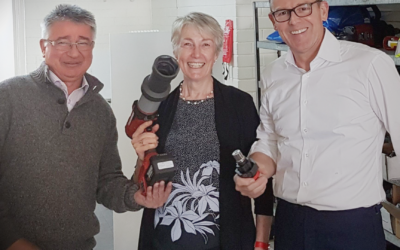After nearly two years of close cooperation including technical workshop trials, laboratory tests and rigorous field trials, Segnut has been officially accepted by BHP for use on fixed plant in its WA Iron Ore operations, as a hazard reduction solution to hot works fires. A formal Management of Change (MoC) document was submitted by BHP’s engineering team in late September and approved, clearing the way for adoption of Segnut.
BHP site engineering staff are now making changes to specifications and drawings to have the product included in the maintenance plans for individual pieces of equipment across the Pilbara in the coming weeks and months.
The motivation for using Segnut has its roots in one of the darkest and most expensive days in BHP’s recent history. In 2017, the screen house at Mount Whaleback mine caught fire – the result of molten metal from hot works igniting a conveyor belt which was still operating and traversing through the screen house. The specific hot works was being done to remove a seized nut.
The damage bill and the cost of lost production ran to hundreds of millions of dollars.
BHP’s engineering team was given the task of identifying engineering controls to minimize, and where possible, eliminate the risk of future fires. The work undertaken over the past three years has seen the world’s biggest miner work with conveyor belt and screen media providers to explore options for flame retardant materials to minimise the risk.
The highest stratum in the hierarchy of safety and risk management, though is Elimination. In Segnut, BHP found a means of removing the need for hot works to remove seized fasteners. By replacing common hexagonal nuts on wear liners and hard skirts on conveyors, BHP aims to remove the risk of a spark – ignited fire in areas of high fuel load, such a screen houses and car dumpers.
Beyond the clear fire safety benefits, the reduction in “rattle gun” use will also significantly reduce the exposure of maintenance staff to Hand-Arm Vibration Syndrome (or “White Knuckle”). Additionally, the much-reduced removal times for Segnut represent an enormous opportunity for BHP to make savings across its fixed and mobile plant maintenance programs.
A major impetus for adoption of Segnut has been that the product requires no special tools, nor changes to the design of the chutes, wear liners or other equipment on which it is employed. While fire prevention and safety have been the main drivers for Segnut’s introduction to BHP’s operations, the company has clear plans to introduce it more broadly across the Minerals Australia business unit. It has the added benefit of being applicable to more than just wear liners and similar consumables, and wider adoption on mobile plant (Ground Engaging Tools) and other equipment is being actively canvassed.
If you would like assistance to explore the potential for Segnut as a fire prevention strategy, or quick release fastener to improve maintenance productivity, please contact Engentus.
.





0 Comments